Vegas Loop Guide, Review & Full Tour
Much has been said about the comeback of Las Vegas as we emerge from the pandemic. While we are still early in the full reopening, it does seem like Vegas is coming back bigger and better than ever. Part of that is people’s desperation and enthusiasm for travel, but the other part is Vegas being Vegas.
You see, going into the pandemic Las Vegas had several new and ambitious projects underway. Some like the new Gateway Arch and the adults only Circa Resort & Casino have now opened while others like Resorts World Las Vegas and the MSG Sphere are still under construction. Then there is the Las Vegas Convention Center and its ambitious Vegas Loop underground project and West Hall expansion.
Las Vegas Convention Center West Hall Expansion & Vegas Loop
CES 2021 was supposed to be the debut of the brand new West Hall Expansion for the convention center. The West Hall adds over 1.4 million square feet to the massive complex including a 14K square foot outdoor terrace, 328K square feet of column free space and a transport system that uses Tesla vehicles driving through Boring Company tunnels also known as Vegas Loop.
The Las Vegas Convention & Visitor’s Authority paid $52.5 million for the loop system built by Boring Company. They opted for this system instead of a traditional people mover type system in a decision that has been controversial. The LVCC Loop portion of Vegas Loop features three stations (including one underground) and two .8 mile long tunnels.
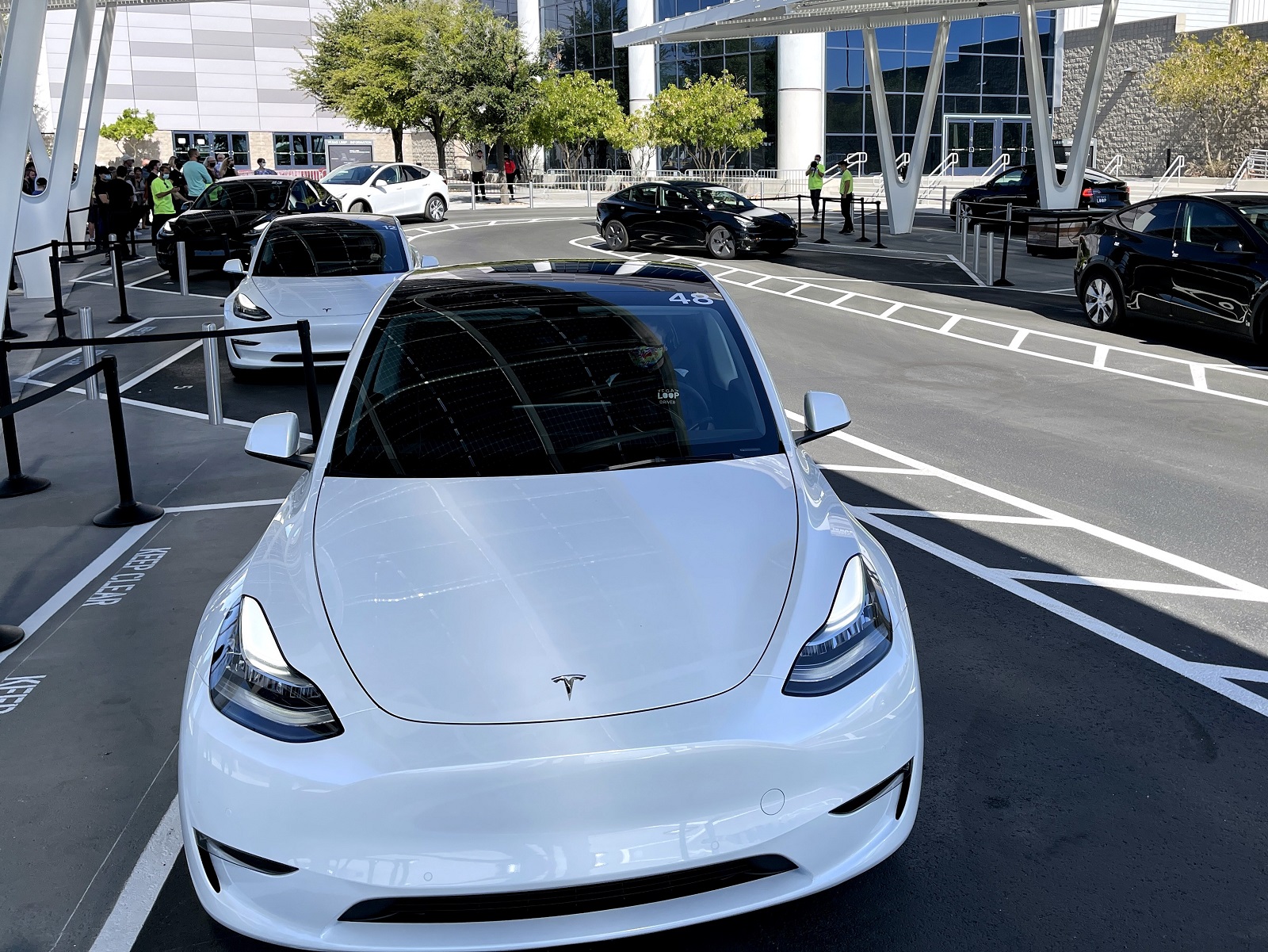
How It Works – Vegas Loop Guides & First Impressions
This week I was able to finally try out Vegas Loop during a capacity test of the system ahead of its opening for the World of Concrete convention in June. In this Vegas Loop guide I’ll share everything I learned from hours worth of rides. While I’ve always thought the system was a good idea from a public relations perspective (I think it will draw people), I do have to admit the usefulness of the system was a question going in.
For example, when they first announced the loop it was supposed to have shuttles carrying 12 guests. Today’s system doesn’t quite do that. It features a fleet of Tesla Model Y, 3 & X vehicles with each carrying 3 passengers. Maybe that sounds bad, but I found they are able to crank through people given each vehicle only stops for about 30 seconds to load and unload. Yes capacity will need to expand as the system does, but they are running what they have well.
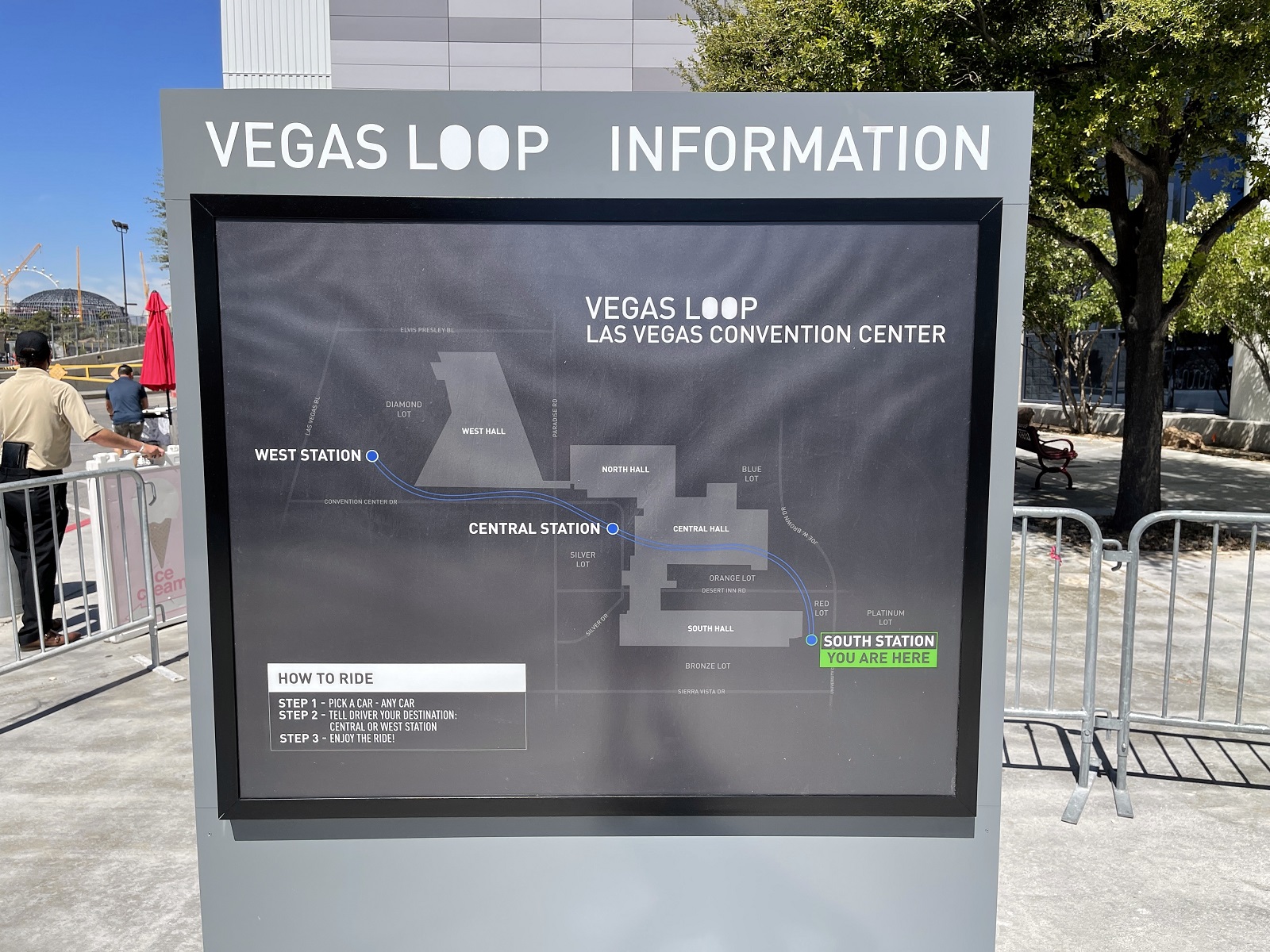
Vegas Loop Guide – How Much Capacity?
The test I attended was to see if they could reach their 4,400 person per hour (each direction) published capacity. While I am not sure if they hit that number, it was clear to me they have been practicing A LOT and the entire system ran like a finely tuned machine. Cars were constantly coming and going and the motion was endless. Add in some fun colorful lights, neat tunnels and quiet electric cars and it made for a great experience. I highly recommend checking out the full video at the beginning of the post.
The Future of Vegas Loop
While the LVCC Loop portion of Vegas Loop is now complete and ready to open, the system is getting ready to expand. Resorts World for example is said to be already working on their expansion to the system with Wynn/Encore getting a station on the same LVCC Loop as well. Both of those hotels are located close to the convention center and tapping into the line will make things convenient for their customers.
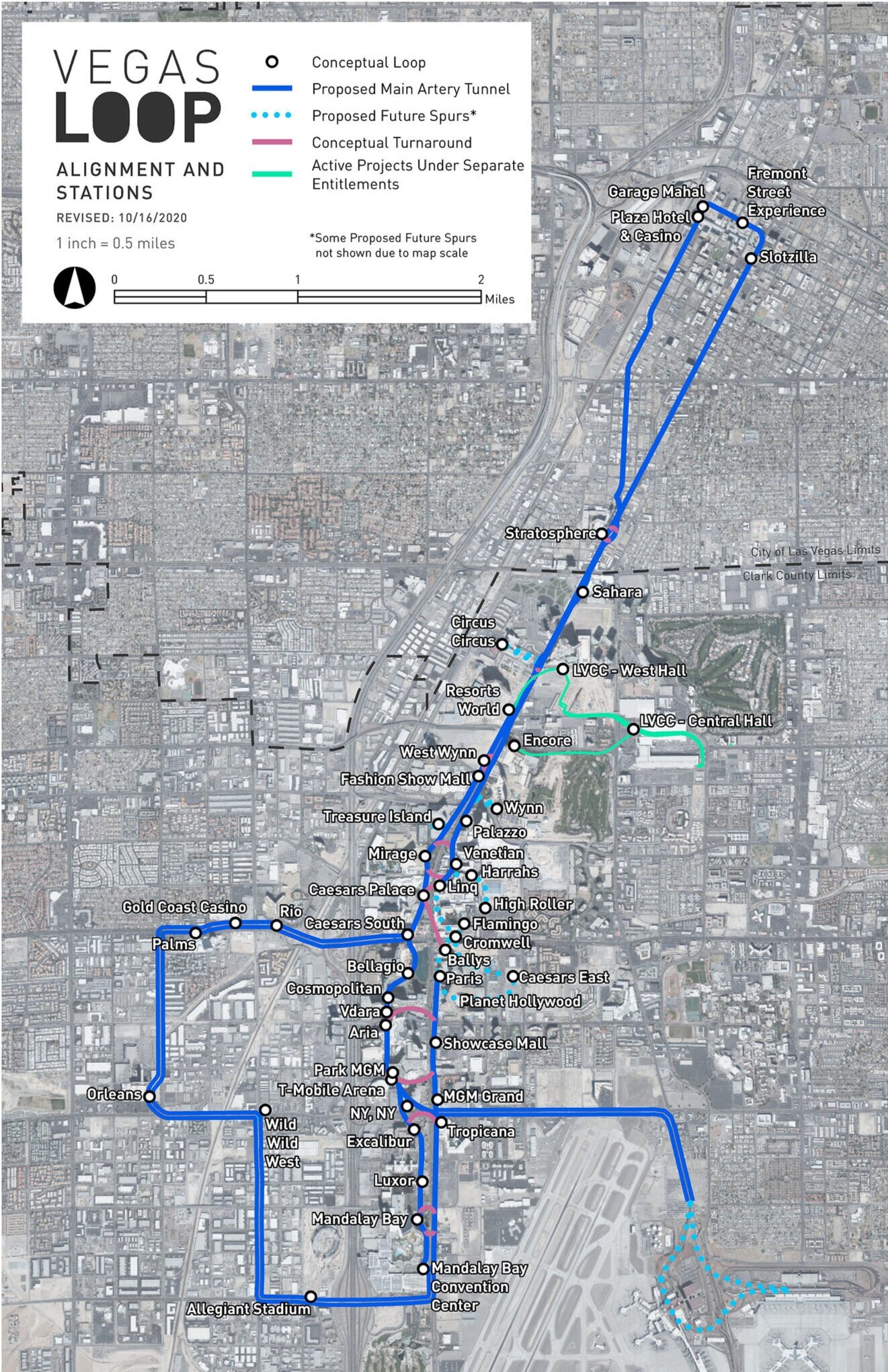
But the real vision is the entire Vegas Loop system (pictured above). Boring has proposed and gotten many approvals to build the system which will have a main set of tunnels along with stations at many of the more popular venues in town. Vegas Loop as proposed will run to Downtown Las Vegas, the Strip, Allegiant Stadium and even the airport. Boring has said they’ll pay for the main tunnels with each property paying for their station on the system.
Vegas Loop – Is It Just “Cars Through Tunnels”
Ultimately the criticism of Vegas Loop is that it isn’t anything new. “It’s just cars in tunnels”, people say. And that’s true on the surface, but it feels much more grand than that. I’m not talking about the cool factor either. I’m talking about the system and how it works. How they load and unload so efficiently. How it is a “pod like” mass transit technology that is here today and not something that is billions of dollars and decades away.
With all of that said I do think Vegas Loop will face some challenges. The tunnels are narrow and that limits speed and capacity. Drivers are expensive too and the automation technology once promised for these vehicles is not anywhere close to being a reality. I do think they’ll have to develop vehicles that aren’t off the shelf Teslas too, but the good news is the tunnels are built and new hardware can be installed. Boring Company delivered the tunnels, stations and system on budget and I can’t wait to see if they can pull off their ambitious plan for the full Vegas Loop, but they definitely have challenges ahead.
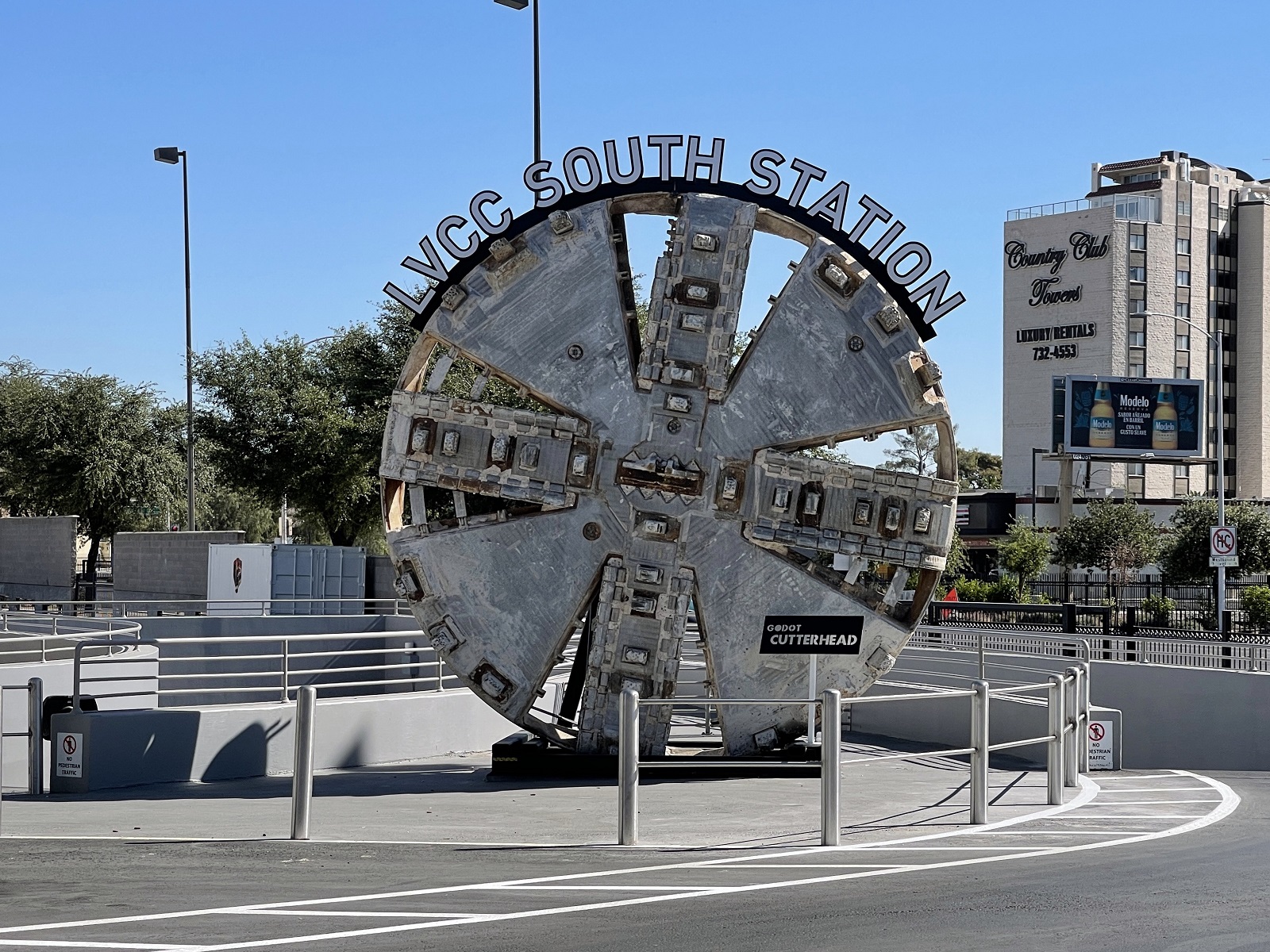
Vegas Loop FAQ
Vegas Loop is opening soon and I know many of you have burning questions about safety, how it works and how it feels. Here are some of the most frequently asked Vegas Loop questions and answers.
- What if a car stalls in the tunnel? – All of the drivers are trained to back the vehicles out of the entire system end to end. This means if a car stalls all of the other cars can clear themselves out while they are able to tow out the broken down vehicle.
- What if you are handicap or need assistance? – While I didn’t get their full policy, the Vegas Loop is running a limited number of Tesla Model X vehicles which are used for handicap passengers. The upward opening Falcon Wing doors of the Model X make it easier to get in and extra handles installed give more leverage. Model X vehicles only stop at the two above ground stations as of this time.
- How fast do the Tesla vehicles go on Vegas Loop? – The average speed is in the low 30MPH range, but vehicles can reach up to 40MPH on the straight portions of Vegas Loop. Check out our video to see a real world example of Vegas Loop speeds.
- How many stations does Vegas Loop have? – At this time the system contains three stations as part of the LVCC Loop portion. Two stations (West & South Stations) are above ground with the Central Station being below ground.
- What is with the disco lights? – Central Station has a special colorful lighting package (see video) as do the tunnels. Normal operation is just white lights, but during special occasions they can turn on the colors to make the experience even more fun.
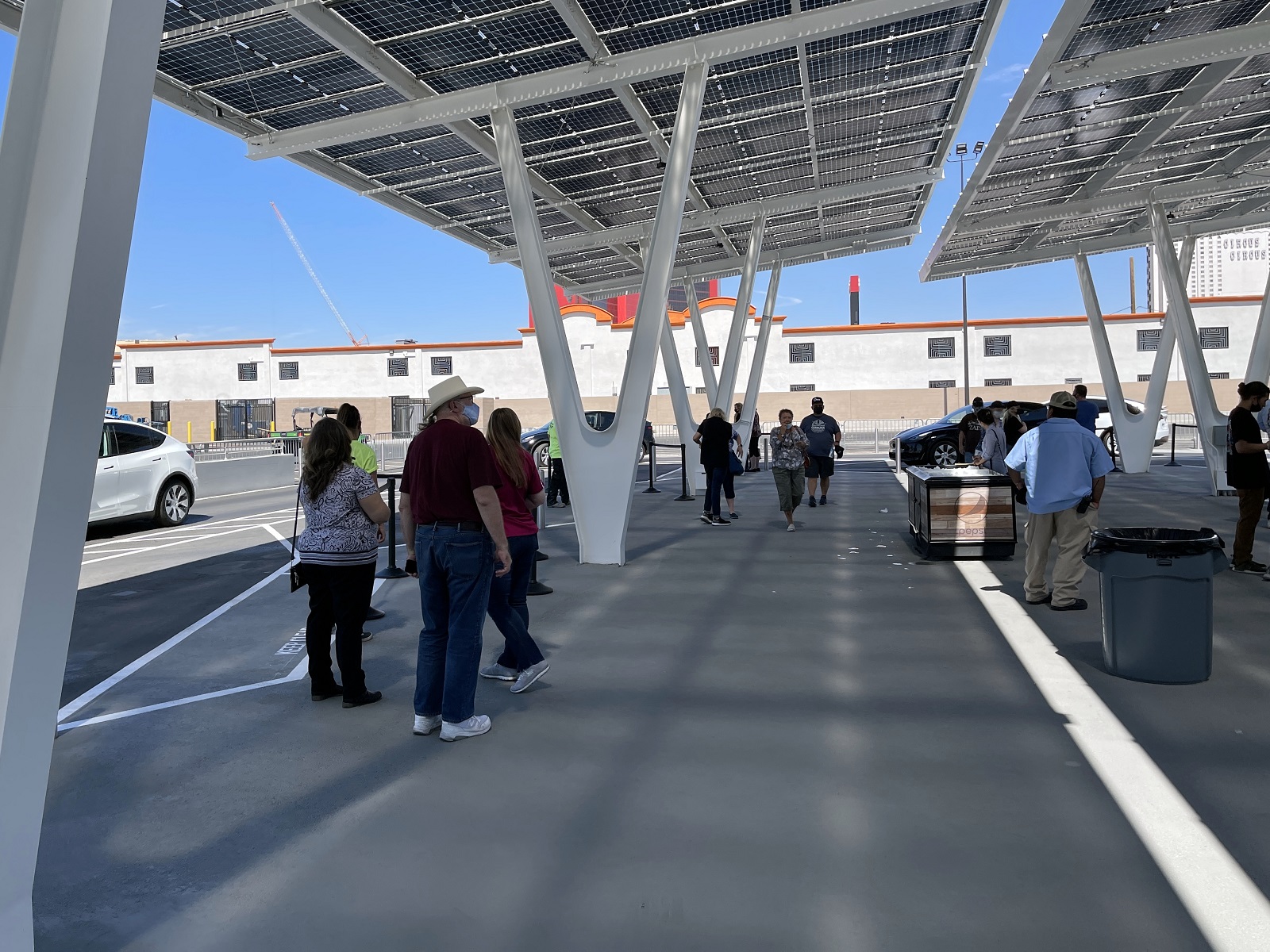
- How do they load the Tesla vehicles on Vegas Loop? – Passengers departing the vehicle are asked to leave the door open and exit towards the front. Passengers coming on approach from the rear and close the door upon entry. It runs very efficiently.
- Where should I stand in the Vegas Loop station? – Vegas Loop utilizes individual slips for each car. Drivers are told to pick the first open slip they reach. This means if you are at one of the last slips in the direction of travel you may wait longer for a car. Try to swim further upstream.
- Are the Vegas Loop tunnels claustrophobic? – I didn’t find them to be claustrophobic and that is something that has been an issue for me from time to time. The cars had more space on the sides than it seems like in the video and it mostly feels like driving through a tunnel in a car in the normal world.
- How do they evacuate the vehicles? – While I didn’t get a 100% answer to this, the tunnels are slightly wider than it looks in the videos and I believe doors would be able to be opened so people could get out. The tunnels are only .8 miles long and you are never far from a station.
Vegas Loop Guide, Review & Full Tour – Bottom Line
I truly enjoyed my time under the Las Vegas Convention Center riding the Vegas Loop and think anyone in Vegas who has the opportunity should ride it. Many will say this system is stupid and I totally see their point of view, but as someone who loves the spectacle of Vegas and what this city tries to do, I think this is a huge win. Vegas Loop is a mass transit system that has the potential to be revolutionary, but which at the very least will draw in crowds, move people and most importantly make sure people continue to talk about and visit Las Vegas.
What do you think? Don’t forget to watch the full video above!



My understanding is that the reason they are using passenger cars to move three people at a time is to comply with state social distancing mandates. Eventually they will have larger electric vehicles moving more people at a time. Since the mandates were only recently lifted that may take some time to develop.
So…if there is a burning Tesla in that narrow tunnel you THINK you could open the door and get out? And get out into a narrow tunnel full of smoke and toxic gases from that burning car…but it’s not too far to run back to the station? Yikes!
I’m sorry but…. it looks pretty reasonable but in this day and age utilizing one car to carry 3-4 people is madness: think of the cost per passenger alone and for what? If they wanted something new and different then what about using the same route with several trolley bus caravans (i.e. three joined and operating as one unit) running on auto mode? Numerous cars with each one a potential hazard and minimal load and high per capita costs is not smart – imho.
Thanks for the video….Can’t wait to check it out at the CBD convention in July.
Two thoughts:
1 – Private sector will virtually always be faster and cheaper with projects such as this. Well done Vegas!
2 – Full Self Driving FSD (released as beta version 9 soon) will allow for maximum efficiency. While these tunnels may not be long, imagine one that connects LA to SF and going 130 MPH.
Thanks for this post and the video. Future is bright!
If my math is correct, “4,400 person per hour (each direction) published capacity” = 73 people per minute. At 3 passengers per car, that’s about 25 cars per minute entering the tunnel at one end and exiting at the other, or about one car every 2 seconds. The video didn’t look like it was averaging better than one every 8-10 seconds. And even if 30 seconds to unload and load is realistic (I have doubt about whether that could be done safely), to get a car moving every 2 seconds would mean you’d need 30 cars simultaneously unloading and loading in the station – it didn’t look like there were enough bays for that. Am I missing something?
Thanks for the tour. I had assumed they’d be using the Autopilot software to automate the cars’ movement through the Loop.